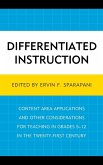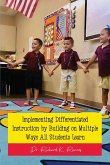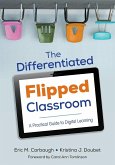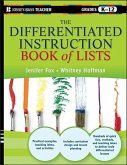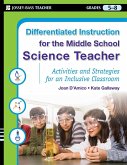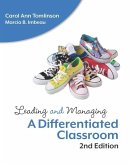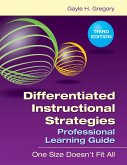Differentiated Instruction
Content Area Applications and Other Considerations for Teaching in Grades 5-12 in the Twenty-First Century
Herausgeber: Sparapani, Ervin F.
Differentiated Instruction
Content Area Applications and Other Considerations for Teaching in Grades 5-12 in the Twenty-First Century
Herausgeber: Sparapani, Ervin F.
- Broschiertes Buch
- Merkliste
- Auf die Merkliste
- Bewerten Bewerten
- Teilen
- Produkt teilen
- Produkterinnerung
- Produkterinnerung
In the current standards-based, accountability-driven world of education, it is difficult for educators to use differentiated instruction to cater to the individual learning needs of each student. This book explains differentiating instruction in a way that connects to current standards and provides examples of challenging best practice lessons.
Andere Kunden interessierten sich auch für
![Differentiated Instruction Differentiated Instruction]() Differentiated Instruction117,99 €
Differentiated Instruction117,99 €![Implementing Differentiated Instruction by Building on Multiple Ways All Students Learn Implementing Differentiated Instruction by Building on Multiple Ways All Students Learn]() Richard K. RamosImplementing Differentiated Instruction by Building on Multiple Ways All Students Learn14,99 €
Richard K. RamosImplementing Differentiated Instruction by Building on Multiple Ways All Students Learn14,99 €![The Differentiated Flipped Classroom The Differentiated Flipped Classroom]() Eric M. CarbaughThe Differentiated Flipped Classroom36,99 €
Eric M. CarbaughThe Differentiated Flipped Classroom36,99 €![The Differentiated Instruction Book of Lists, Grades K-12 The Differentiated Instruction Book of Lists, Grades K-12]() Jenifer FoxThe Differentiated Instruction Book of Lists, Grades K-1229,99 €
Jenifer FoxThe Differentiated Instruction Book of Lists, Grades K-1229,99 €![Differentiated Instruction for the Middle School Science Teacher Differentiated Instruction for the Middle School Science Teacher]() Karen E D'AmicoDifferentiated Instruction for the Middle School Science Teacher27,99 €
Karen E D'AmicoDifferentiated Instruction for the Middle School Science Teacher27,99 €![Leading and Managing a Differentiated Classroom Leading and Managing a Differentiated Classroom]() Carol Ann TomlinsonLeading and Managing a Differentiated Classroom36,99 €
Carol Ann TomlinsonLeading and Managing a Differentiated Classroom36,99 €![Differentiated Instructional Strategies Professional Learning Guide Differentiated Instructional Strategies Professional Learning Guide]() Gayle H. GregoryDifferentiated Instructional Strategies Professional Learning Guide41,99 €
Gayle H. GregoryDifferentiated Instructional Strategies Professional Learning Guide41,99 €-
-
In the current standards-based, accountability-driven world of education, it is difficult for educators to use differentiated instruction to cater to the individual learning needs of each student. This book explains differentiating instruction in a way that connects to current standards and provides examples of challenging best practice lessons.
Hinweis: Dieser Artikel kann nur an eine deutsche Lieferadresse ausgeliefert werden.
Hinweis: Dieser Artikel kann nur an eine deutsche Lieferadresse ausgeliefert werden.
Produktdetails
- Produktdetails
- Verlag: University Press of America
- Seitenzahl: 282
- Erscheinungstermin: 1. April 2015
- Englisch
- Abmessung: 229mm x 152mm x 15mm
- Gewicht: 413g
- ISBN-13: 9780761865544
- ISBN-10: 0761865543
- Artikelnr.: 42194244
- Herstellerkennzeichnung
- Libri GmbH
- Europaallee 1
- 36244 Bad Hersfeld
- gpsr@libri.de
- Verlag: University Press of America
- Seitenzahl: 282
- Erscheinungstermin: 1. April 2015
- Englisch
- Abmessung: 229mm x 152mm x 15mm
- Gewicht: 413g
- ISBN-13: 9780761865544
- ISBN-10: 0761865543
- Artikelnr.: 42194244
- Herstellerkennzeichnung
- Libri GmbH
- Europaallee 1
- 36244 Bad Hersfeld
- gpsr@libri.de
Edited by Ervin F. Sparapani
List of Figures List of Tables Foreword by Pamela L. Ross McClain
Acknowledgments Introduction, by Ervin F. Sparapani Part I: About
Differentiated Instruction 1. The Nature of Instruction, by Ervin F.
Sparapani 2. About Differentiated Instruction, by Ervin F. Sparapani, Ryan
H. Walker, and Marie E. Van Tiflin 3. Standards and Benchmarks and
Differentiated Instruction: Integrating Approaches to Teaching and
Learning, by Nicole M. Rogers and Barbara Garii. 4. Assessment: A Guiding
Force for Differentiation, by Byung-In Seo and Deborah L. Smith Part II:
Differentiated Instruction and Content Area Applications 5. Differentiating
Instruction and Teaching the Middle School and High School English Language
Arts, by Shannon Pietras 6. Differentiating Instruction for Teaching Middle
School and High School Mathematics, by Gary Malburg and David K. Pugalee 7.
Differentiating Instruction and Teaching Middle School and High School
Science, by Jonathon A. Gould and Betsy Diegel 8. Differentiated
Instruction and Inquiry-Based Learning in Middle School and High School
Social Studies, by C. Rodney Williams 9. Differentiating Instruction and
Teaching the Middle School and High School Arts, by Carolyn J. Shaeffer and
Scott R. Kirst Part III: Differentiated Instruction and Other
Considerations for Grades 5-12 10. Differentiating Instruction and Teaching
for Higher-Level Thinking: The Thinking/Learning (T/L) System, by Ervin F.
Sparapani and Patricia L. Calahan 11. Using Technology to Differentiate
Instruction, by Amy M. Cooper and C. Rodney Williams 12. Response to
Intervention (RTI): A System to Meet the Needs of All Students in Grades
5-12, by Deborah L. Smith 13. Dropouts and Differentiation: Toward
Understanding and Prevention, by Brian J. Smith 14. Differentiated
Instruction: Strategies for Students with Moderate and Severe Disabilities,
by Dorothy Squatrito Millar Index
Acknowledgments Introduction, by Ervin F. Sparapani Part I: About
Differentiated Instruction 1. The Nature of Instruction, by Ervin F.
Sparapani 2. About Differentiated Instruction, by Ervin F. Sparapani, Ryan
H. Walker, and Marie E. Van Tiflin 3. Standards and Benchmarks and
Differentiated Instruction: Integrating Approaches to Teaching and
Learning, by Nicole M. Rogers and Barbara Garii. 4. Assessment: A Guiding
Force for Differentiation, by Byung-In Seo and Deborah L. Smith Part II:
Differentiated Instruction and Content Area Applications 5. Differentiating
Instruction and Teaching the Middle School and High School English Language
Arts, by Shannon Pietras 6. Differentiating Instruction for Teaching Middle
School and High School Mathematics, by Gary Malburg and David K. Pugalee 7.
Differentiating Instruction and Teaching Middle School and High School
Science, by Jonathon A. Gould and Betsy Diegel 8. Differentiated
Instruction and Inquiry-Based Learning in Middle School and High School
Social Studies, by C. Rodney Williams 9. Differentiating Instruction and
Teaching the Middle School and High School Arts, by Carolyn J. Shaeffer and
Scott R. Kirst Part III: Differentiated Instruction and Other
Considerations for Grades 5-12 10. Differentiating Instruction and Teaching
for Higher-Level Thinking: The Thinking/Learning (T/L) System, by Ervin F.
Sparapani and Patricia L. Calahan 11. Using Technology to Differentiate
Instruction, by Amy M. Cooper and C. Rodney Williams 12. Response to
Intervention (RTI): A System to Meet the Needs of All Students in Grades
5-12, by Deborah L. Smith 13. Dropouts and Differentiation: Toward
Understanding and Prevention, by Brian J. Smith 14. Differentiated
Instruction: Strategies for Students with Moderate and Severe Disabilities,
by Dorothy Squatrito Millar Index
List of Figures List of Tables Foreword by Pamela L. Ross McClain
Acknowledgments Introduction, by Ervin F. Sparapani Part I: About
Differentiated Instruction 1. The Nature of Instruction, by Ervin F.
Sparapani 2. About Differentiated Instruction, by Ervin F. Sparapani, Ryan
H. Walker, and Marie E. Van Tiflin 3. Standards and Benchmarks and
Differentiated Instruction: Integrating Approaches to Teaching and
Learning, by Nicole M. Rogers and Barbara Garii. 4. Assessment: A Guiding
Force for Differentiation, by Byung-In Seo and Deborah L. Smith Part II:
Differentiated Instruction and Content Area Applications 5. Differentiating
Instruction and Teaching the Middle School and High School English Language
Arts, by Shannon Pietras 6. Differentiating Instruction for Teaching Middle
School and High School Mathematics, by Gary Malburg and David K. Pugalee 7.
Differentiating Instruction and Teaching Middle School and High School
Science, by Jonathon A. Gould and Betsy Diegel 8. Differentiated
Instruction and Inquiry-Based Learning in Middle School and High School
Social Studies, by C. Rodney Williams 9. Differentiating Instruction and
Teaching the Middle School and High School Arts, by Carolyn J. Shaeffer and
Scott R. Kirst Part III: Differentiated Instruction and Other
Considerations for Grades 5-12 10. Differentiating Instruction and Teaching
for Higher-Level Thinking: The Thinking/Learning (T/L) System, by Ervin F.
Sparapani and Patricia L. Calahan 11. Using Technology to Differentiate
Instruction, by Amy M. Cooper and C. Rodney Williams 12. Response to
Intervention (RTI): A System to Meet the Needs of All Students in Grades
5-12, by Deborah L. Smith 13. Dropouts and Differentiation: Toward
Understanding and Prevention, by Brian J. Smith 14. Differentiated
Instruction: Strategies for Students with Moderate and Severe Disabilities,
by Dorothy Squatrito Millar Index
Acknowledgments Introduction, by Ervin F. Sparapani Part I: About
Differentiated Instruction 1. The Nature of Instruction, by Ervin F.
Sparapani 2. About Differentiated Instruction, by Ervin F. Sparapani, Ryan
H. Walker, and Marie E. Van Tiflin 3. Standards and Benchmarks and
Differentiated Instruction: Integrating Approaches to Teaching and
Learning, by Nicole M. Rogers and Barbara Garii. 4. Assessment: A Guiding
Force for Differentiation, by Byung-In Seo and Deborah L. Smith Part II:
Differentiated Instruction and Content Area Applications 5. Differentiating
Instruction and Teaching the Middle School and High School English Language
Arts, by Shannon Pietras 6. Differentiating Instruction for Teaching Middle
School and High School Mathematics, by Gary Malburg and David K. Pugalee 7.
Differentiating Instruction and Teaching Middle School and High School
Science, by Jonathon A. Gould and Betsy Diegel 8. Differentiated
Instruction and Inquiry-Based Learning in Middle School and High School
Social Studies, by C. Rodney Williams 9. Differentiating Instruction and
Teaching the Middle School and High School Arts, by Carolyn J. Shaeffer and
Scott R. Kirst Part III: Differentiated Instruction and Other
Considerations for Grades 5-12 10. Differentiating Instruction and Teaching
for Higher-Level Thinking: The Thinking/Learning (T/L) System, by Ervin F.
Sparapani and Patricia L. Calahan 11. Using Technology to Differentiate
Instruction, by Amy M. Cooper and C. Rodney Williams 12. Response to
Intervention (RTI): A System to Meet the Needs of All Students in Grades
5-12, by Deborah L. Smith 13. Dropouts and Differentiation: Toward
Understanding and Prevention, by Brian J. Smith 14. Differentiated
Instruction: Strategies for Students with Moderate and Severe Disabilities,
by Dorothy Squatrito Millar Index


